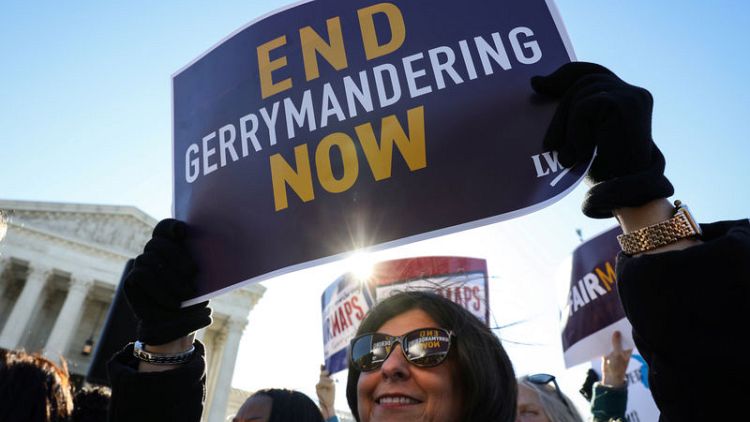By Andrew Chung and Lawrence Hurley
WASHINGTON (Reuters) - Some conservative U.S. Supreme Court justices on Tuesday signalled scepticism towards whether judges have a role in curbing the contentious practice of manipulating electoral district boundaries to entrench one party in power.
As the oral arguments continue in two major cases, it appeared the court - which has a 5-4 conservative majority - would be closely divided on whether courts can limit partisan gerrymandering, with the liberal justices appearing more sympathetic to the idea of intervening.
The justices last year failed to deliver a definitive ruling on the legality of partisan gerrymandering. They got another chance in the cases before them on Tuesday challenging North Carolina's Republican-drawn statewide U.S. House of Representatives map and a single Democratic-drawn House district in Maryland.
"Why should we wade into this?" conservative Justice Neil Gorsuch asked.
Fellow conservatives Chief Justice John Roberts and Justice Samuel Alito also asked probing questions. Justice Brett Kavanaugh, like Gorsuch an appointee of President Donald Trump, was less aggressive in questioning lawyers for North Carolina voters who challenged the practice.
Critics have said gerrymandering has become increasingly effective and insidious by using precise voter data and powerful computer software. The result in many states has been the creation of electoral districts, sometimes oddly shaped to include or exclude certain localities, that maximize one party's chances of winning and diluting the clout of voters who tend to support the other party.
Gerrymandering also tends to foster the election of candidates with more extreme views at the expense of moderates, according to critics, adding to U.S. political polarization.
The two cases are among the most important that the court will consider in its current term, with rulings due by the end of June. The outcome could impact U.S. elections for decades either by allowing federal courts to curb partisan gerrymandering or by removing their power to do so, giving gerrymandering-minded state legislators a freer hand.
About 150 people held an anti-gerrymandering rally in front of the court before the arguments. Some demonstrators held signs that said, "Unrig our democracy."
Virginia Kase, CEO of the League of Women Voters civic organization, said in a statement, "Banning partisan gerrymandering would make huge strides in restoring voters' faith in the electoral process. Voters must know their votes make a real difference and that they are not just used as pawns in a political game."
Gerrymandering is carried out by cramming as many like-minded voters as possible into a small number of districts and spreading the rest in other districts too thinly to form a majority.
Plaintiffs in the two cases - Democratic voters in North Carolina and Republican voters in Maryland - have said the maps were drawn to diminish their voting power, violating their constitutional rights. In both cases, lower courts ruled that the contested districts violated the U.S. Constitution's guarantee of equal protection under the law, the right to free speech and association, or constitutional provisions governing elections.
While the Supreme Court, which currently has a 5-4 conservative majority, has ruled in the past against gerrymandering intended to harm the electoral clout of racial minorities, it has never reined in gerrymandering carried out purely for partisan advantage.
North Carolina's Republican legislators have said judges are not equipped to determine how much politics is too much in electoral line-drawing. Plaintiffs have said turning away gerrymandering claims would be a green light for even more ruthless redistricting.
The North Carolina case focuses on how Republican legislators reworked House districts in 2016 to ensure that 10 Republicans were elected to House seats, compared to just three Democrats, in a state whose voters are closely divided between the two parties. Noting that partisan gerrymandering was not illegal, Republicans were open about their intent.
(To see a graphic showing the effect of the plan in Greensboro, North Carolina, click here: https://tmsnrt.rs/2HC8mvU)
"I think electing Republicans is better than electing Democrats," state House Representative David Lewis said at the time.
Using those words as evidence, more than two dozen Democratic voters, the North Carolina Democratic Party and two groups that advocate for fair elections sued.
In the Maryland case, Republican voters sued after the Democratic-controlled legislature redrew boundaries of their House district in a way that removed Republican-leaning areas and added Democratic-leaning areas. The move flipped the seat from Republican to Democrat.
Legislative districts across the country are redrawn to reflect population changes determined by the federal census each decade. In most states, redistricting is done by the party in power, though some assign the task to independent commissions in the interest of fairness.
(Reporting by Andrew Chung; Editing by Will Dunham)
